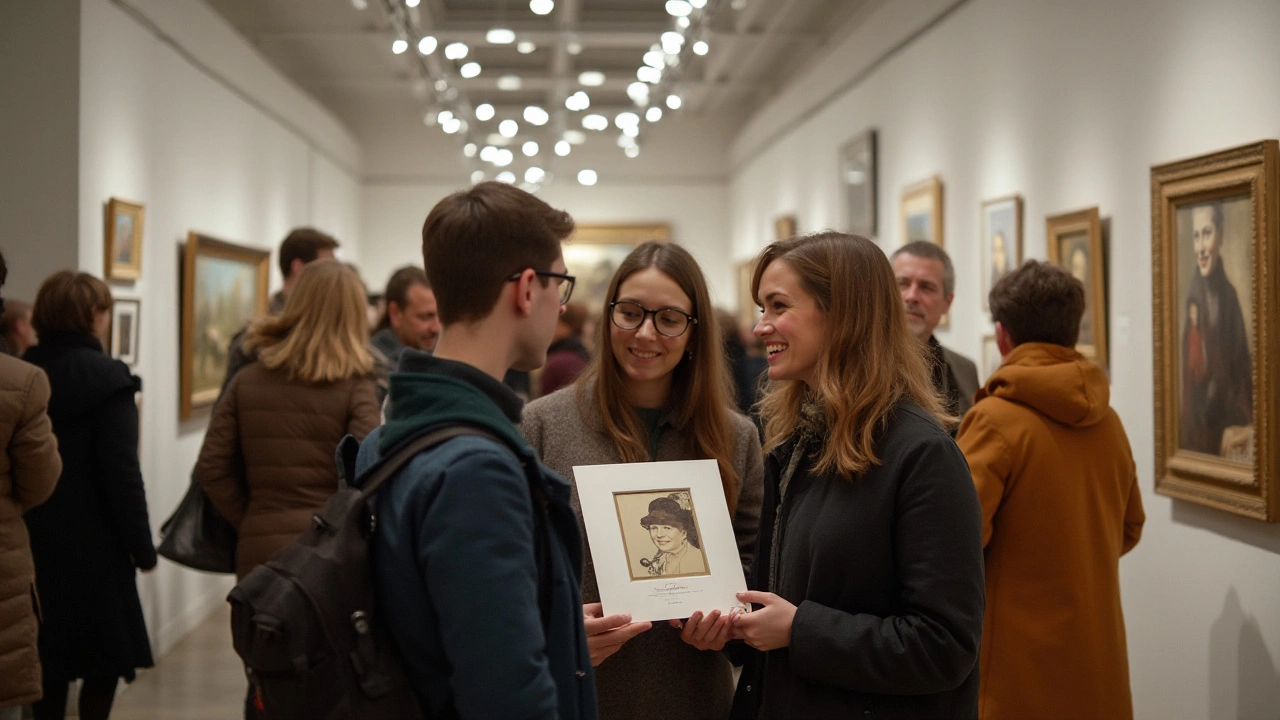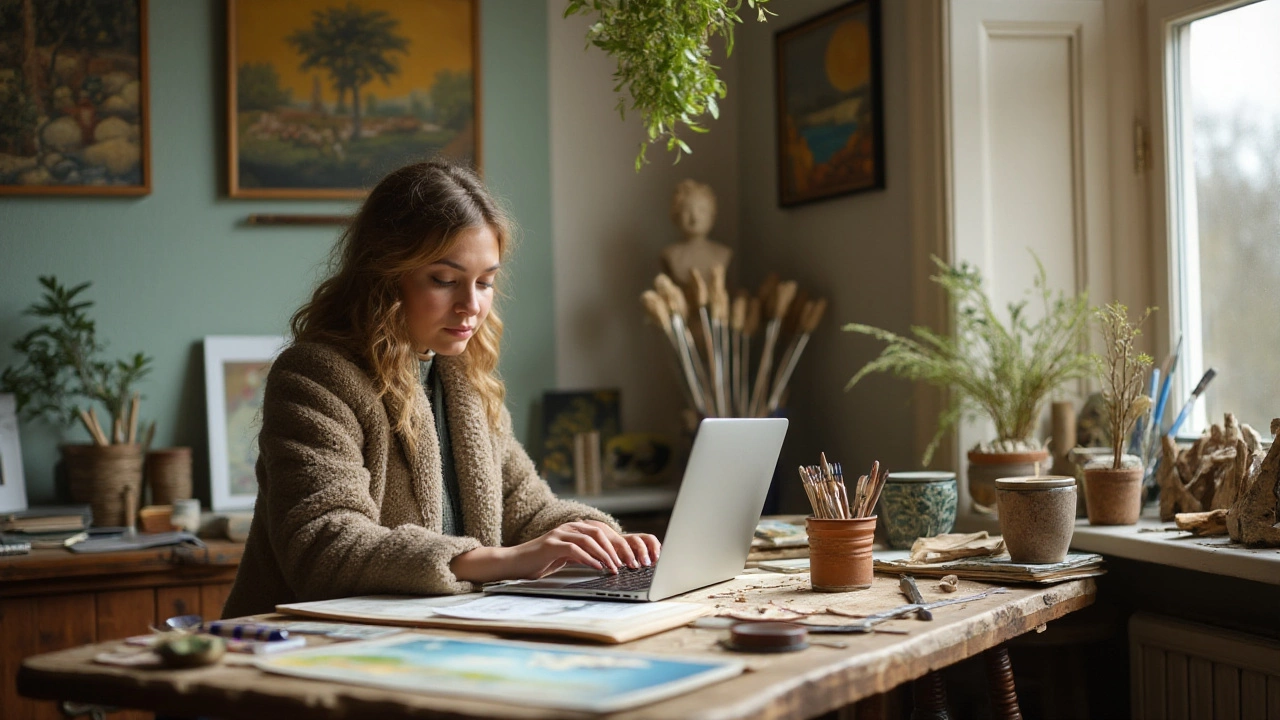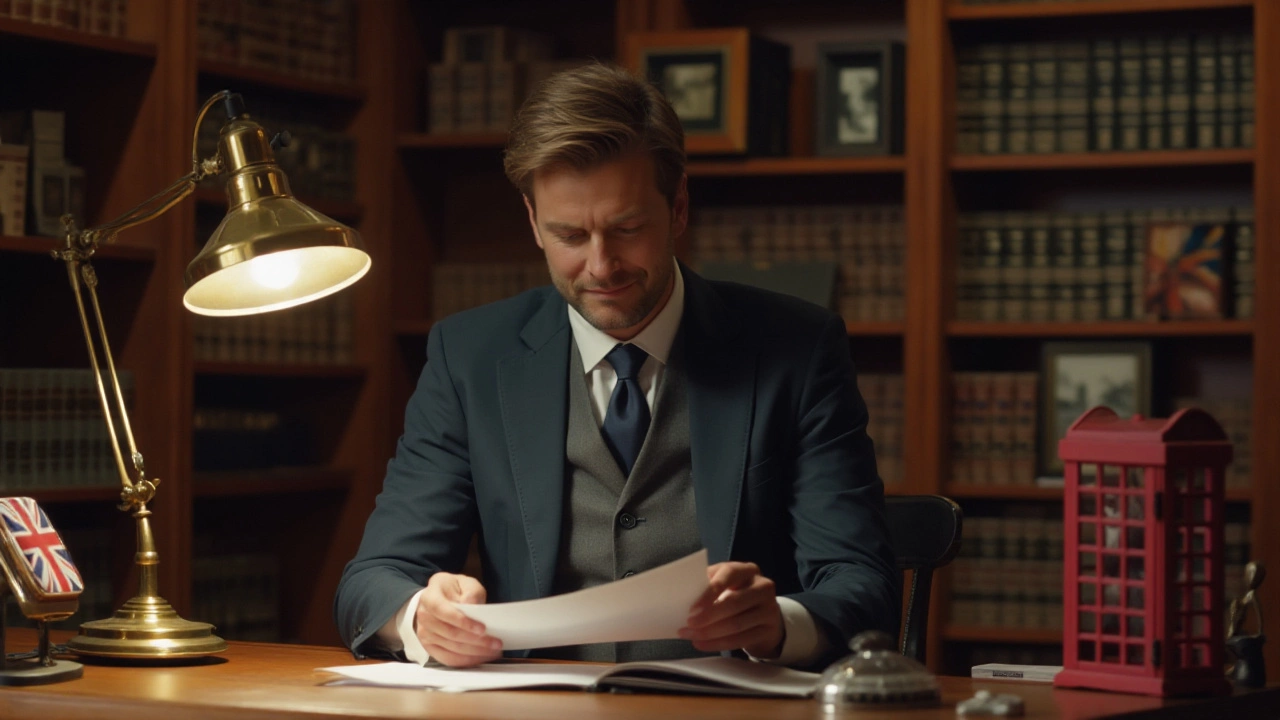Art has a unique way of expressing emotions, telling stories, and capturing imagination. With the digital age bringing masterpieces within a click’s reach, the temptation to print a favorite piece for personal use arises. However, this raises an interesting question on the legality of such actions.
Understanding what constitutes 'personal use' and how copyright laws play into printing art is essential. This conversation not only safeguards your actions but also respects the hard work and creativity of artists worldwide. It's important to strike the right balance between admiration and legality in the world of art.
- Introduction to Art and Copyright
- Defining Personal Use in Art
- Legal Aspects of Printing Art
- Tips for Legal Art Printing
- Consequences of Copyright Infringement
- Respecting Artists' Rights
Introduction to Art and Copyright
The world of art is as extensive as it is vibrant, encompassing a range of forms, styles, and expressions that echo throughout history. One key aspect that keeps this world both protected and complex is the notion of copyright. As artists pour their souls into their creations, copyright laws step in as a shield, safeguarding these works from misuse and unauthorized reproduction. In essence, copyright as a legal concept serves to recognize the artist as the original creator, granting them exclusive rights over their creations.
This protection stems from the moment an artwork is created and fixed in a tangible form, such as a painting, drawing, or digital image. The law sees the creator as the only one with the legal right to reproduce the work, prepare derivative works based on it, distribute copies, and even display the work publicly. Fascinatingly, these rights last for an extensive period, often the lifetime of the artist plus an additional 70 years, a duration that reflects the critical need to protect creators' legacies. Without such laws, the freedom to disseminate, modify, or financially benefit from an artist's labors without their consent would leave creators vulnerable. Art printing for any purpose must respect these guarded rights.
International agreements, such as the Berne Convention for the Protection of Literary and Artistic Works, ratified by most countries, establish a common framework under which these rights are enforced globally. These treaties ensure that copyrights are respected across borders, fostering a global respect for intellectual property. Yet, with each nation interpreting these guidelines slightly differently, a diverse legal landscape emerges, making it pivotal for enthusiasts to understand their local laws when considering printing art, even for personal use.
Still, many people find themselves perplexed at where their admiration for art extends into the realm of legality. Could printing a favorite piece for personal enjoyment breach these protective boundaries? This quandary invites both reflection and awareness. It's important to note that the primary essence of copyright is to control reproduction and distribution, aspects keenly engaged when an individual decides to print a digital image. "The best art is that which opens not only our eyes but also our minds and our hearts," states renowned artist and critic John Berger in a
quote reflective of art's profound impact on the observer, echoing the importance of respecting the laws protecting its source.
Digital technology's advance, while broadening artistic reach, has simultaneously magnified challenges around copyright compliance. Websites abound with digital versions of artwork, creating easy access to masterpieces, yet these same platforms impose clear usage restrictions. For instance, downloading an image might be free, but using it beyond desktop wallpaper or social media profile photos requires a licensed agreement. As innovators, already strategizing on how to integrate new technologies responsibly into the art world, copyright reform is recurrently placed on the agenda for international artistic advisory boards.
The scope of copyright also extends into digital works, where online platforms often set their own usage policies, aligning with but sometimes diverging from copyright doctrines. This convergence of technology and law shapes a digital frontier, fostering both creativity and legal awareness. Meanwhile, organizations such as Creative Commons have made a significant mark by providing alternative licensing options, allowing artists to waive certain rights voluntarily to encourage greater flexibility in artistic sharing. These licenses exemplify creators' capacity to tailor their rights according to their artistic visions while educating the public on proper use. In an era where collaborations and accessibility define progressive art cultures, such measures highlight the art community's adaptability and readiness to embrace legal complexities with innovative solutions.
Defining Personal Use in Art
When we talk about the term "personal use" in the context of art, it often refers to the non-commercial actions individuals take to enjoy art privately. This could mean downloading and printing a famous painting to hang in your living room or crafting a personalized gallery wall in your office. While art printing for one's private enjoyment does seem harmless enough on the surface, it's essential to understand how it aligns with copyright laws. A significant distinction to note is that personal use excludes activities that generate any form of direct financial benefit, such as selling prints or using them in advertisements.
Globally, copyright laws fundamentally protect artists from unauthorized reproduction of their work. In the U.S., for instance, the Copyright Act intends to ensure artists receive their deserved credit and compensation. While personal use is typically not a focal point of enforcement, it is still technically covered under these laws. An understanding of what constitutes personal use can vary slightly depending on local legislations. For example, New Zealand's copyright statute may interpret personal use slightly differently. Artists usually hold the copyright unless explicitly waived, giving them control over reproductions.
Personal use often thrives in a gray area, where downloading an artwork for non-profit purposes might seem trivial yet remains legally complex. Interestingly, the advent of the internet and digital media has made art more accessible, thus increasing the instances of printing art at home. Nevertheless, a study conducted by the European Union found that 60% of individuals were unaware of the boundaries between personal use and copyright infringement when it comes to digital content, highlighting a widespread knowledge gap.
"Understanding personal use within copyright law means knowing that some uses are inherently acceptable, but others infringe upon the creator's rights," shared Dr. Louise Andrews, an intellectual property lawyer based in New York.
So what exactly is allowed under personal use? Ideally, non-commercial activities such as printing art for a personal scrapbook, or a school art project are less likely to provoke legal issues. Yet, if questioned, a solid grasp of your jurisdiction's policies is indispensable. Some jurisdictions provide exceptions for educational purposes, where using art as part of a learning environment might not breach copyright if due credit is accorded. Knowing this can aid in making informed decisions regarding art printing for personal benefit without crossing legal boundaries.
In the realm of digital art, where virtually any piece could be available at your fingertips, preserving the integrity of personal use goes a long way in protecting artists' rights while simultaneously indulging in the joys of art ownership or admiration. Keeping abreast with technology's impacts on art legality and the nuanced distinctions of copyright help fortify personal use rights without stepping into infringement territory.

Legal Aspects of Printing Art
Navigating the legality of art printing for personal use is a nuanced endeavor. At the core is copyright law, which grants artists control over how their works are reproduced and distributed. Copyright is an automatic right that exists as soon as a piece of art is created and doesn't require any formal registration. This protection typically extends to most forms of artistic expressions like paintings, photographs, and sculptures. However, the specifics of these laws can vary considerably from one country to another, leading to potential complexities.
The concept of 'personal use' in the realm of copyright generally refers to reproducing art without commercial intent. This ideal scenario implies that you're printing the art solely for private enjoyment without selling, displaying, or distributing it. Yet, even within this seemingly simple framework, there's room for legal gray areas. Not all art is created equal, and some might fall into what can be termed as public domain. Artworks created a significant time ago, generally over 70 years after the artist's death, often enter this niche, freeing them from traditional copyright constraints.
However, it's crucial to recognize that some digital platforms might offer art for personal use under specific licenses. These licenses typically outline the scope of reproduction allowed and the necessary credits that must accompany any printing. It's wise to read these licenses carefully to avoid unintended infringement.
"In the digital age, access to art has been greatly democratized, yet the responsibility to uphold artists' rights is more critical than ever." — The International Copyright Society
In some cases, artists themselves might offer prints or digital copies under particular terms which allow personal use. Engaging directly with artists not only ensures you remain legally protected but also supports their craft, arguably enriching the personal enjoyment you're seeking. When considering legal art reproduction methods, exploring platforms that have licenses such as Creative Commons can provide a wealth of options. These platforms provide clear rules and guidelines on how the artworks can be used, often without infringing on copyrights.
However, it's imperative to remember that ignorance of copyright laws does not exempt one from potential legal consequences. Hence, a fundamental understanding of these laws and how they pertain to personal use is key. As artists continue to share their creativity with the world, it's only fair to honor the framework that protects their rights to the fruits of their labor. By doing so, you not only enrich your personal space but also contribute to sustaining a vibrant art community.
Tips for Legal Art Printing
For those who adore art and want to bring pieces into personal spaces legally, it’s crucial to understand a few guidelines. First and foremost, always ensure that the artwork you want to print is in the public domain. This means that the artist has been deceased for over 70 years, freeing the work from copyright protections. You can easily find vast libraries of public domain art online. Many websites categorize this type of art, making it straightforward to navigate.
Another handy tip is to seek the artist’s permission directly if the artwork doesn’t fall into the public domain. Artists often appreciate when enthusiasts respect their creations enough to ask, and you might be surprised at how many are willing to grant permission for personal use. It's a great way to connect with artists and support their endeavors. Some might ask for a small fee, which can also contribute to supporting their future works.
Utilizing stock photo websites that offer royalty-free images is another practical route. While they may not always house the most famous pieces, these sites can provide excellent art options that are legally cleared for personal use. Remember, though, to read the terms and conditions carefully. Not all stock photos are free for use as art prints, and some may have restrictions concerning print size and distribution.
It's also possible to look for art specifically licensed under Creative Commons. This licensing allows creators to share their work with specific permissions – some allow modifications, while others might only permit usage with no alterations. Using these works not only keeps you within legal boundaries but also supports a culture of sharing and collaboration in the art community. A proper credit to the creator, often outlined in licensing terms, is usually required and is just a respectful practice.
“Art is not freedom from discipline, but disciplined freedom.” – John F. Kennedy
For those keen on modern art reproduction, legal prints can be sourced from museums and galleries that offer official copies. Many institutions create high-quality replicas of their collections for public purchase. This avenue assures that your purchase supports the arts ethically and legally. Keep an eye on museum gift shops or their online stores for such opportunities.
Lastly, never underestimate the power of educating yourself. The internet is a treasure trove of resources, including blogs, articles, and forums discussing legal art reproduction. Engaging in detailed community discussions and learning from others' experiences can provide valuable insights. Encouraging respect for art printing laws not only protects your actions but fosters a supportive environment for creatives worldwide. Remember, being an informed enthusiast is as vital as being a passionate one.

Consequences of Copyright Infringement
In the realm of art printing, trespassing into the territory of copyright infringement can lead to numerous consequences, which might not only be legally burdensome but also financially draining. Copyright laws are in place to protect the original creations of artists, and when these are not respected, repercussions can follow swiftly. One of the most common consequences is the issuance of a lawsuit against the infringing party. Lawsuits concerning copyright can lead to substantial legal fees, court appearances, and, in some cases, significant settlements or fines.
Apart from monetary penalties, there's the potential for reputational damage. For individuals, being involved in a copyright infringement case can cast a shadow over one's personal and professional life, particularly in fields that highly value ethical practices. For businesses involved in art reproduction or sale, the scandal can deter clients, leading to a loss of trust and business opportunities. Intellectual property laws are complex, and when violated, the consequences can reverberate throughout one's life, disrupting personal relations and business partnerships.
To exemplify, consider the case of Richard Prince, who faced legal action for using photographs without permission. This case highlighted the blurred lines artists often navigate between inspiration and infringement. A court ruling emphasized the importance of transforming the original work significantly enough to deem it new, raising awareness among creators around the globe. Insiders noted that such cases serve as significant reminders about the importance of understanding copyright boundaries.
Copyright law also encompasses a moral dimension, obliging individuals to respect the creative effort behind every piece of art. By infringing upon these rights, individuals not only risk legal action but also contravene the ethical obligations owed to artists. This moral wrongdoing can be significant within creative communities, where credit and appreciation contribute to fostering an environment ripe for innovation and creativity. Ethically, respecting these rights encourages an atmosphere where artists feel secure in sharing their work, promoting a lively and diverse artistic ecosystem.
In considering copyright infringement related to art prints, the saying 'prevention is better than cure' holds tremendous truth. Educating oneself about copyright laws and seeking permissions where necessary can avert many unwanted consequences. For those enamored with collecting or recreating art, understanding these rights serves as dual purpose: honoring the artist's rights and ensuring a peaceable personal hobby, free from legal entanglements. Thus, it promotes a wholesome creative environment where art can be celebrated and shared responsibly and legally.
Respecting Artists' Rights
One of the most crucial aspects of engaging with art prints is understanding and respecting the rights of the artists who create these captivating pieces. Artists pour their creative souls into their work, and it's imperative that their copyrights are acknowledged, observed, and protected. Copyright is the legal protection given to creators, ensuring they have control over how their artwork is used and reproduced. In a world that increasingly values digital accessibility, it becomes all the more important to be conscious of these rights, especially when considering options to print art for personal use.
When you decide to print art, even for personal enjoyment, you're entering a complex legal landscape. The intent behind 'personal use' can vary, but in general terms, it means using the art for non-commercial purposes like decorating a room or gifting to a friend — as long as there's no intention to make a profit. However, the lines can blur, and it’s crucial to be diligent in seeking permissions when necessary. Printing without the consent of the artist can be a direct infringement on their rights. Acknowledging this not only maintains the integrity of the legal system but also celebrates the creative endeavor itself.
"The purpose of copyright is not directly to reward the creator, but to benefit the public by encouraging creativity," once observed Jessica Litman, a legal scholar known for her expertise on copyright law.
To navigate these waters, it is often wise to connect with the artist or their representatives and ask for permission. Many artists are approachable and open to their works being appreciated, as long as their terms are respected. Some might offer specific guidelines or terms under which they will allow reproductions. Artistic communities thrive best on trust, respect, and transparency, resulting in a richer cultural tapestry for everyone involved. Digital platforms selling art prints often have integrated systems that ensure artists are compensated and their rights respected. It's worth capitalizing on these resources if you're keen on legally acquiring rights-compliant prints.
In instances where artists are no longer living, or the work is old yet still under copyright, organizations like Creative Commons have emerged to simplify navigating permission frameworks. They offer licenses that allow for various levels of freedom in sharing and using art. Whether you're just an art lover or someone compiling a collection, options exist to respect artists' legal rights while honoring their artistry in your space. Through conscious efforts, art enthusiasts can pave the way for future generations of creators, ensuring they choose to continue sharing their talents with the world without the fear of misuse or misappropriation.

